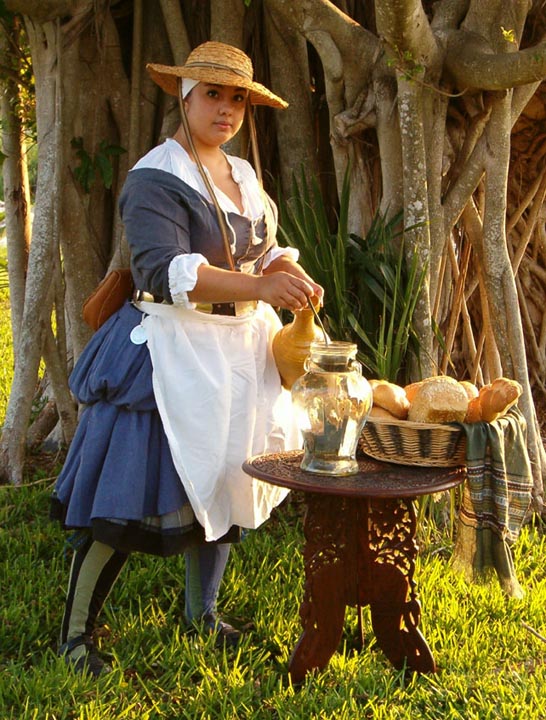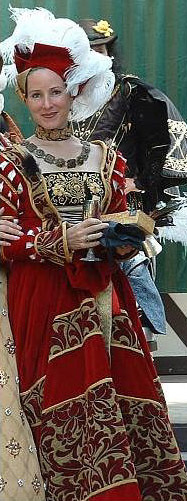Category:German Garb
15 century
- Shaube A ladies Jacket
- Hemd litteral german for 'Shirt', a Low necked Chemise, usually embroidered long the front.
- Cuspinian Dress
- wulsthaube A round muffin shaped hat, sometimes having gold embroidery.
16 century

Typical Styles for Women
During the 16th century the style of women’s clothing changed dramatically from the relatively unstructured gowns of the Housebook Master to the very tailored structured Spanish influenced styles of the 1570’s.
There are some consistencies throughout the century however:
- Front closing bodices Soft curves over the bust indicating that the bust was supported but not flattened as in Spanish, French and English styles. No gratuitous displays of cleavage however.
- High-necked smocks, with and without ruffs/ruffles
- Flat waistlines, the extreme pointed styles of Spanish, English and French fashion were picked up in the very late 1590’ and only by the upper class.
- Sewn in sleeves
- Bodice and gown are sewn together
- Aprons
- Covered hair. Although towards the middle of the century barrets and hats began to be adopted by women, women always wore something on their heads. Only girls went bareheaded or with a pearled headband on, grown women never did.
Typical layers, from the skin out
- Smock, made of linen
- Corset or bodice
- Petticoat, could be several
- Dress
- Gollar, shoulder cape
- Apron
- Head covering
- Stockings
Typical Styles for Men
Men’s clothing also underwent a serious transformation from the beginning of the century to the end, with the fashion staring out as hose and jerkin, transitioning to Rocks (gowns) and then transitioning to the Spanish influenced styles of doublet, jerkin and breeches. There are a lot more extant examples of men’s clothing from the period than there are of women’s, Janet Arnold’s book Pattern’s of Fashion does a good job of explaining the different types of men’s garments in the second half of the century.
Unlike women’s clothing that just changed the styles of the layers, men’s clothing changed the layers involved completely.
Glossary of German Costuming Terms

*Bärentatzen- Bear paw shoe.
- Barett- Flat cap, with or without feathers.
- Baterlein- Rosary.
- Bruche, Bruech, Brouche- Breeches.
- Brüstle,Brustleib, Brüstlein- Bodice, with or without sleeves.
- Brusttuch/Brustfleck Possibly the name for the plastron
- Bundhaube- Coif
- Calotte- A generally close fitting cap/coif of gold or silk often decorated with a network of gold or silver cord. - Source: Kathy Barich
- Entenschnäbel- Duck billed shoe - Source: Kathy Barich
- Faltenrock- Pleated gown or coat - Source: Julie Adams
- Filzrock-A gown with felted inlays or trim - Source: Kathy Barich
- Flügel-Long hanging sleeves - Source: Kathy Barich
- Flügelrock-A festive dress with long hanging sleeves, often seen in Nuremberg. - Source: Kathy Barich
- Frauenhemd- Woman's shirt
- Gansbaugh-"Goose belly" or peascod belly style doublet
- Gebende A general headdress term, meaning banded. It is used especially where a band attaches the hat to the chin. Also a Turban, and used to describe the "Pork Pie" headress
- Geknäuften Kogeln- Buttoned hood
- Gestaltrock- "Form coat" that could be put on or slung around the shoulders
- Glocken (literally bell) Round buttoned cloaks - Source: Kathy Barich
- Goldhaube- Gold Cap
- Goller- "Collar" shoulder length cape, often richly decorated , also used to describe the English style partlet
- Gugel/Kogel/Kugel-Hood - Source: Kathy Barich
- Haarhauben Hair cap - Source: Julie Adams
- Halshemd Shirt with high collar? (neck shirt) - Source: Kathy Barich
- Harzkappe-Tighter form of the Shaube with sleeves only to the elbow - Source: Kathy Barich
- Haube- Cap - Source: Julie Adams
- Hemd- Shirt, also any white linen garment worn under clothing by both men and women
- Herrenhütte- Lord's hat
- Heuke- A cloak flowing from the crown of the head to the ground, also a2. circular or near circular cloak -Source: Kathy Barich
- Holzschuhe- Wooden shoe - Source: Kathy Barich
- Husecke- Fur lined mantle with hanging sleeves
- Joppe- Bodice, with or without sleeves
- Kittel Smock
- Kleid Dress in general
- Knöpfstiefel Buttoned boots
- Korsett Corset
- Kotte Robe
- Krantz Chain garland worn on the head
- Kühmauler "Cow Mouth" - broad toed shoes
- Mantel Cloak
- Monschkutte Monk's robe
- Nachtschauben Nightcoat, housecoat or morning coat
- Ochsenmäuler Oxen mouth shoes, also Kühmauler
- Paltrock Pleated gown or coat
- Pantoffel Slipper
- Pelz Fur
- Pluderhose Men's knee length baggy paned breeches, particularly identified with Landsknechte, often using thin silk called Kartek or Rasch
- Puffjacke Puffed jacket meant for riding, also called Reitrocke
- Ränder broad toed shoes
- Regentuch Rain cloth or cover
- Reifrocke Petticoats
- Reisekappe Another term for Reisemantel : riding coat specifically the garde-corps
- Reisemantel riding coat specifically the garde-corps\
- Rennrocklein Racing doublet where tails of the doublet were long than 10 to 14cm
- Ritterhütte Knight's hat
- Schaube Wide shouldered cloak, also described as a cassock and a mantle
- Schaubelein Short flaring jacket
- Schlappe Cap with ear pieces that tie over head
- Schleier Veil
- Schleppen Train
- Schnabelschue Pointed toe shoes
- Schozwams Tailed doublet
- Schurz Apron
- Schwanzrock -A gown with a train
- Sorket Surcoat
- Stiefe Boots
- Streufflinge Over breeches for riding
- Strickbarett Small flat cap with small brim
- Strümphe Socks/stockings
- Stumpfe Schue Blunt toed shoes
- Stützpolster Support bolster, "bum roll"
- Stützrocke Support skirt- farthingale
- Suckenie Surcoat
- Tappert/ Trappers/ Traphart Short male overgarment, I like to think "tabard" - Source: Kathy Barich
- Teufelsfenstern "Devil's Window" the "Gates of Hell" surcoat - Source: Kathy Barich
- Toghe Shoulder cape - Source: Kathy Barich
- Trippen Inner shoes
- Tunika Tunic
- Uberkleid Overdress
- Unterhemd Undershirt
- Unterhosen Underpants
- Unterröcke Underskirt
- Unterschue Pattens, wood clog undershoes
- Wams Doublet
- Wappenrock A coat with armorial bearings, sometimes just the coat worn over the armor
- Wäsche Underwear- literally “the wash”
Links
Pages in category "German Garb"
The following 7 pages are in this category, out of 7 total.